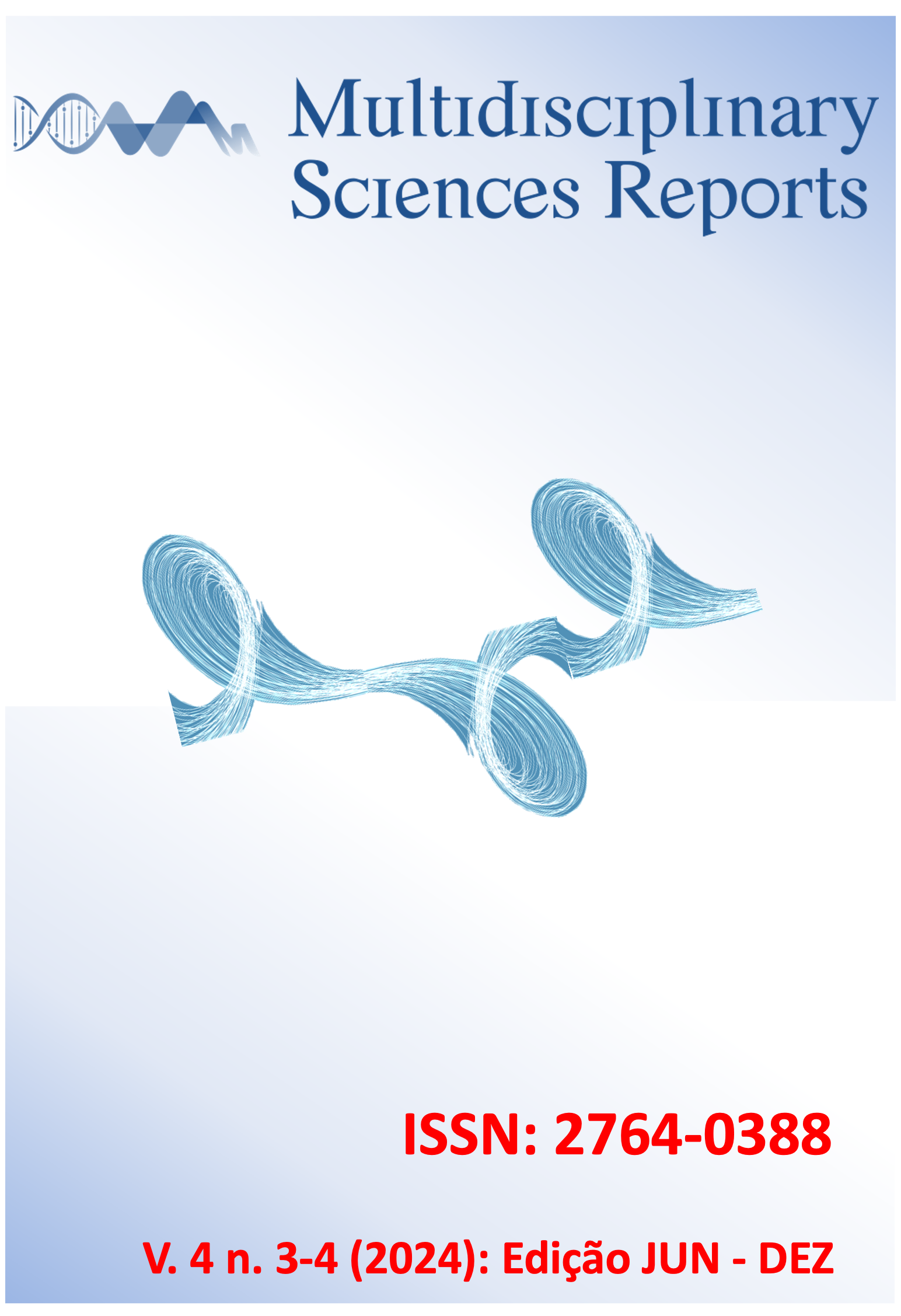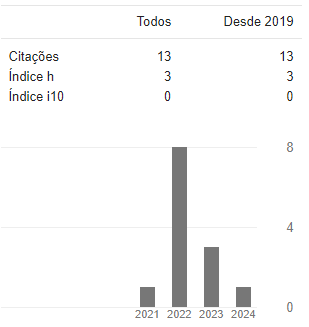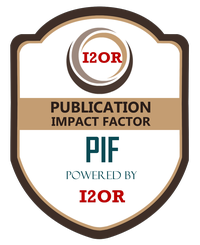ABORDAGENS FISIOTERAPÊUTICAS PARA A REDUÇÃO DA SEVERIDADE DO TRAUMA PERINEAL OBSTÉTRICO: UMA REVISÃO INTEGRATIVA
Visualizações: 178DOI:
https://doi.org/10.54038/ms.v4i3-4.58Palavras-chave:
Laceração perineal, assoalho pélvico, trauma perineal, prevenção, parto vaginalResumo
O trauma perineal durante o parto vaginal é caracterizado como uma situação comum que está associado à morbidade de curto e longo prazo, como dor persistente, dispareunia, distúrbios do assoalho pélvico e depressão. O objetivo deste estudo foi realizar uma revisão integrativa para identificar as abordagens fisioterapêuticas realizadas nos últimos onze anos que reduzem a gravidade do trauma perineal, bem como os tipos de estudos realizados e as evidências científicas que sustentam seu uso. Em janeiro de 2022 uma busca sistematizada foi realizada usando quatro bases de dados eletrônicas: PubMed, Embase, SCOPUS e WEB OF SCIENCE. O protocolo de busca incluiu estudos publicados desde o ano de 2011 a 2022, que abordassem um ou mais recursos fisioterapêuticos durante o período gestacional e/ou trabalho de parto, sem restrição de idioma. A estratégia de busca utilizada em cada base de dados incluiu termos padronizados do Medical Subject Heandings (MeSH), Descritores em Ciências da Saúde (DeCS) e 32 palavras-chave. A Preferred Reporting Items for Systematic Reviews and Meta-analysis (PRISMA) foi utilizado para fazer a seleção dos estudos e excluir os registros duplicados. Diante do exposto, é possível inferir que dentre as técnicas avaliadas nos estudos, a prática de massagem nos músculos de assoalho pélvico durante a gestação e treinamento por meio de exercícios perineais podem ser eficazes na diminuição da incidência de lacerações graves e episiotomia durante o parto.
Referências
Aguiar, M. et al. Birth-Related Perineal Trauma in Low- and Middle-Income Countries: A Systematic Review and Meta-analysis. Matern. Child Health J. 23, 1048–1070 (2019). DOI: https://doi.org/10.1007/s10995-019-02732-5
Abedzadeh-Kalahroudi, M., Talebian, A., Sadat, Z. & Mesdaghinia, E. Perineal trauma: incidence and its risk factors. J. Obstet. Gynaecol. (Lahore). 39, 206–211 (2019). DOI: https://doi.org/10.1080/01443615.2018.1476473
Gutzeit, O., Levy, G. & Lowenstein, L. Postpartum Female Sexual Function: Risk Factors for Postpartum Sexual Dysfunction. Sex. Med. 8, 8–13 (2020). DOI: https://doi.org/10.1016/j.esxm.2019.10.005
Cattani, L., De Maeyer, L., Verbakel, J. Y., Bosteels, J. & Deprest, J. Predictors for sexual dysfunction in the first year postpartum: A systematic review and meta-analysis. BJOG An Int. J. Obstet. Gynaecol. 129, 1017–1028 (2022). DOI: https://doi.org/10.1111/1471-0528.16934
Tähtinen, R. M. et al. Long-term Impact of Mode of Delivery on Stress Urinary Incontinence and Urgency Urinary Incontinence: A Systematic Review and Meta-analysis. Eur. Urol. 70, 148–158 (2016). DOI: https://doi.org/10.1016/j.eururo.2016.01.037
Trutnovsky, G., Kamisan Atan, I., Martin, A. & Dietz, H. P. Delivery mode and pelvic organ prolapse: a retrospective observational study. BJOG An Int. J. Obstet. Gynaecol. 123, 1551–1556 (2016). DOI: https://doi.org/10.1111/1471-0528.13692
Pergialiotis, V., Bellos, I., Fanaki, M., Vrachnis, N. & Doumouchtsis, S. K. Risk factors for severe perineal trauma during childbirth: An updated meta-analysis. Eur. J. Obstet. Gynecol. Reprod. Biol. 247, 94–100 (2020). DOI: https://doi.org/10.1016/j.ejogrb.2020.02.025
Pierce-Williams, R. A. M., Saccone, G. & Berghella, V. Hands-on versus hands-off techniques for the prevention of perineal trauma during vaginal delivery: a systematic review and meta-analysis of randomized controlled trials. J. Matern. Neonatal Med. 34, 993–1001 (2021). DOI: https://doi.org/10.1080/14767058.2019.1619686
Priddis, H., Dahlen, H. & Schmied, V. Women’s experiences following severe perineal trauma: A meta-ethnographic synthesis. J. Adv. Nurs. 69, 748–759 (2013). DOI: https://doi.org/10.1111/jan.12005
Bick OBE, D., Hall, J. & Keighley, M. R. B. The impact of severe perineal trauma on a woman’s relationship with her child: a hidden consequence. Midwifery 108, 103323 (2022). DOI: https://doi.org/10.1016/j.midw.2022.103323
Whittemore, R. & Knafl, K. The integrative review: Updated methodology. J. Adv. Nurs. 52, 546–553 (2005). DOI: https://doi.org/10.1111/j.1365-2648.2005.03621.x
Liberati, A. et al. The PRISMA statement for reporting systematic reviews and meta-analyses of studies that evaluate health care interventions: explanation and elaboration. Journal of clinical epidemiology vol. 62 (2009). DOI: https://doi.org/10.1016/j.jclinepi.2009.06.006
Melnyk BM, Fineout-Overholt E. Making the case for evidence-based practice.In: Melnyk BM, Fineout-Overholt E. Evidence-based practice in nursing & healthcare. A guide to best practice. Philadelphia: Lippincot Williams & Wilkins;2005.p.3-24. DOI: https://doi.org/10.1037/t68160-000
Azón, E. et al. Actualización sobre la efectividad y evidencia del masaje perineal ante-natal. An. Sist. Sanit. Navar 44, 437–444 (2021). DOI: https://doi.org/10.23938/ASSN.0976
Álvarez-González, M., Leirós-Rodríguez, R., Álvarez-Barrio, L. & López-Rodríguez, A. F. Prevalence of perineal tear peripartum after two antepartum perineal massage techniques: A non-randomised controlled trial. J. Clin. Med. 10, (2021). DOI: https://doi.org/10.3390/jcm10214934
Abdelhakim, A. M. et al. Antenatal perineal massage benefits in reducing perineal trauma and postpartum morbidities: a systematic review and meta-analysis of randomized controlled trials. Int. Urogynecol. J. 31, 1735–1745 (2020). DOI: https://doi.org/10.1007/s00192-020-04302-8
Dieb, A. S. et al. Perineal massage and training reduce perineal trauma in pregnant women older than 35 years: a randomized controlled trial. Int. Urogynecol. J. 31, 613–619 (2020). DOI: https://doi.org/10.1007/s00192-019-03937-6
Delgado, A., Maia, T., Melo, R. S. & Lemos, A. Birth ball use for women in labor: A systematic review and meta-analysis. Complement. Ther. Clin. Pract. 35, 92–101 (2019). DOI: https://doi.org/10.1016/j.ctcp.2019.01.015
Rodríguez-Blanque, R., Sanchez-Garcia, J. C., Sanchez-Lopez, A. M., Expósito-Ruiz, M. & Aguilar-Cordero, M. J. Randomized Clinical Trial of an Aquatic Physical Exercise Program During Pregnancy. JOGNN - J. Obstet. Gynecol. Neonatal Nurs. 48, 321–331 (2019). DOI: https://doi.org/10.1016/j.jogn.2019.02.003
Rise, E., Bø, K. & Nystad, W. Is there any association between abdominal strength training before and during pregnancy and delivery outcome? The Norwegian Mother and Child Cohort Study. Brazilian J. Phys. Ther. 23, 108–115 (2019). DOI: https://doi.org/10.1016/j.bjpt.2018.06.006
Ugwu, E. O., Iferikigwe, E. S., Obi, S. N., Eleje, G. U. & Ozumba, B. C. Effectiveness of antenatal perineal massage in reducing perineal trauma and post-partum morbidities: A randomized controlled trial. J. Obstet. Gynaecol. Res. 44, 1252–1258 (2018). DOI: https://doi.org/10.1111/jog.13640
Schantz, C. Methods of preventing perineal injury and dysfunction during pregnancy: CNGOF Perineal prevention and protection in obstetrics. Gynecol. Obstet. Fertil. Senol. 46, 922–927 (2018).
Leon-Larios, F., Corrales-Gutierrez, I., Casado-Mejía, R. & Suarez-Serrano, C. Influence of a pelvic floor training programme to prevent perineal trauma: A quasi-randomised controlled trial. Midwifery 50, 72–77 (2017). DOI: https://doi.org/10.1016/j.midw.2017.03.015
Brito, L. G. O., Ferreira, C. H. J., Duarte, G., Nogueira, A. A. & Marcolin, A. C. Antepartum use of Epi-No birth trainer for preventing perineal trauma: systematic review. Int. Urogynecol. J. 26, 1429–1436 (2015). DOI: https://doi.org/10.1007/s00192-015-2687-8
Du, Y., Xu, L., Ding, L., Wang, Y. & Wang, Z. The effect of antenatal pelvic floor muscle training on labor and delivery outcomes: a systematic review with meta-analysis. Int. Urogynecol. J. 26, 1415–1427 (2015). DOI: https://doi.org/10.1007/s00192-015-2654-4
Beckmann MM & Stock OM. Antenatal perineal massage for reducing perineal trauma (Review) Beckmann MM, Stock OM Antenatal perineal massage for reducing perineal trauma (Review). Cochrane Database Syst. Rev. Rev. (2013). DOI: https://doi.org/10.1002/14651858.CD005123.pub3
Walker, C. et al. Alternative model of birth to reduce the risk of assisted vaginal delivery and perineal trauma. Int. Urogynecol. J. 23, 1249–1256 (2012). DOI: https://doi.org/10.1007/s00192-012-1675-5
Venugopal V, Deenadayalan B, Maheshkumar K, Yogapriya C, Akila A, Pandiaraja M, et al. Perineal Massage for Prevention of Perineal Trauma and Episiotomy During Labor: A Systematic Review and Meta-Analysis. J Family Reprod Health 2022; 16(3): 162-9. DOI: https://doi.org/10.18502/jfrh.v16i3.10575
Downloads
- PDF PORT 12
- PDF ENG (English) 22
Publicado
Como Citar
Edição
Seção
Accepted 2024-12-23
Published 2025-02-14














